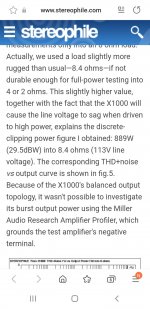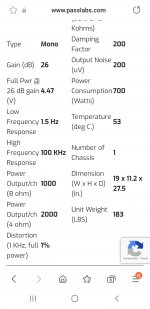You're book is wrong.I was referring to Zen Mod’s comment, about it being said that PL is cheatingly declaring distortion levels. Though not directly spelled like that, it has been implied:
The attached pic, and the word information falsification (if my understanding of German is still correct), correlates to saying «cheating» in my book.
I already translated that conclusion in Post 94:
"
"This Pass X-600.5 shows after service in general good results.
Especially the very low THD and the signal purity based on the spread of second- and third order harmonics.
The bandwidth is something special because it's confined like with many Pass amplifiers."
Ver
I realize my German is very weak after many years nlt using it. Apologies!You're book is wrong.
I already translated that conclusion in Post 94:
"
"This Pass X-600.5 shows after service in general good results.
Especially the very low THD and the signal purity based on the spread of second- and third order harmonics.
The bandwidth is something special because it's confined like with many Pass amplifiers."
Additional questions to German engineer translated:
"If you realized that the output power at 8 ohms was 100 watts too small and at 4 ohms 500 watts too small, weren't you alarmed that something was wrong? Do you think if the power amplifiers both work on a stable 240 volt (with Variac device) AC voltage that the 600 watts at 8 ohms and 1200 watts at 4 ohms is feasible? (Also the measured 405 watts idle should be 600 watts according to the manufacturer. Maybe the distortion value of 1% is reached earlier, at a lower output power levels?
"If you realized that the output power at 8 ohms was 100 watts too small and at 4 ohms 500 watts too small, weren't you alarmed that something was wrong? Do you think if the power amplifiers both work on a stable 240 volt (with Variac device) AC voltage that the 600 watts at 8 ohms and 1200 watts at 4 ohms is feasible? (Also the measured 405 watts idle should be 600 watts according to the manufacturer. Maybe the distortion value of 1% is reached earlier, at a lower output power levels?
So Stereophile, which is a professional reviewing publication for decades say they can't afford a power line that wouldn't sag at least 1000 watts.
I live in a 50 years old comunist block having its mains powered by the worst aluminium wires ever made by the romanian communist industry and my power line inside the apartment is at least 6 meters long to the first mains socket yet if I put a 2500 watts heater in the voltage goes from 230V to 210V ac ...
Now I want to understand what line sag are they talking about at 113V...I thought
the american standard was 110V... They did continuous power tests, they complain of not being able to do burst power tests.You are able to measure the line voltage sag with a 10 bucks multimeter in a continuous test...
So who's sagging here: the mains or the amplifier?
Why this fuzziness? Because they are talking about NP and they can't allow telling strong words...
Then SNR at 82.5db A weighted...really? I won't comment on distortions, Pass amps are known for their distortion signature , but my phono preamps have better SNR than this power amp...
Attachments
Last edited:
All sorts of excuses not to measure max power into 4ohms. Or into 8ohms 🙂
Did they wait for Atkinson to go on leave?
Translation: Gigantic the output at 8 Ohms. At low impedance, the power amplifier decreases significantly.
German Audio Magazine 1998 also stated 1034 Watts at 8 Ohm and 1218 Watts at 4 Ohm.
Any real arguments perhaps? NP (and ZM for that matter) are grown up guys that can defend themselves - if needed at all in this thread - pretty well I think. The don't need this sucking up. It only fuels a kind of implied Guru status that any questions about the performance of his products is undermining his divine authority.This is a troll from the OP, no one was looking for answers, just how the pass lab power rating could be so wrong...other trolls jump in as they like throwing rocks at the guy on top of the hill and all who would defend him....if we stop feeding them they will go back to the shadows and find some other goat to suck on....yes this a DIY forum where Nelson, ZM and many others give away their VAST knowledge for FREE, using it as access to Nelson to vent your dissatisfaction about unsubstantiated testing on a commercial product conducted 7 years ago is bad form, supporting and attempting to legitimize this is disrespectful trolling.
I expressed my admiration for both NP and ZM many times also in this thread. As said I've had numerous NP products from a Threshold Stasis 3, S/1000's, SA/1's, S500's, X600 and X600.5. and still my amplification is from NP nowadays. It was the first time I stumbled on a set of measurements I did not expect. I asked it not in a proper way, the question should have been more open as ZM rightly suggested, but it is still a valid question IMO.
Answers from the German engineer:
Question: If you realized that the output power at 8 ohms was 100 watts too small and at 4 ohms 500 watts too small, weren't you alarmed that something was wrong?
Answer: "No not at all. I know the cleaned up data from the manufacturers. Don't worry the amplifiers are absolute okay!
Question: Do you think if the power amplifiers both work on a stable 240 volt (with Variac device) AC voltage that the 600 watts at 8 ohms and 1200 watts at 4 ohms is feasible?
Answer: You can definitely get closer to the 600 watts. However, it is important at which distortion is measured (1.0, 1.1, 1.2, 1.3, 1.4.... %) All this has a strong influence on the ouput powerratings.
Question: Also the measured 405 watts idle should be 600 watts according to the manufacturer. Maybe the distortion value of 1% is reached earlier, at a lower output power levels?
Answer: No, that has nothing to do with it! I have set the quiescent current in consultation with the customer, as far as I can remember.
Question: If you realized that the output power at 8 ohms was 100 watts too small and at 4 ohms 500 watts too small, weren't you alarmed that something was wrong?
Answer: "No not at all. I know the cleaned up data from the manufacturers. Don't worry the amplifiers are absolute okay!
Question: Do you think if the power amplifiers both work on a stable 240 volt (with Variac device) AC voltage that the 600 watts at 8 ohms and 1200 watts at 4 ohms is feasible?
Answer: You can definitely get closer to the 600 watts. However, it is important at which distortion is measured (1.0, 1.1, 1.2, 1.3, 1.4.... %) All this has a strong influence on the ouput powerratings.
Question: Also the measured 405 watts idle should be 600 watts according to the manufacturer. Maybe the distortion value of 1% is reached earlier, at a lower output power levels?
Answer: No, that has nothing to do with it! I have set the quiescent current in consultation with the customer, as far as I can remember.
Would anyone conceive an independent reviewer measuring a QSC RMX2450 when it sells for 15 years and still in production?
https://www.qsc.com/solutions-products/power-amplifiers/portable/2-channel/rmxa-series/rmx-2450a/
Of course not cause QSC takes three positions in any top 10 Soundstage amp and no 1 is ocuppied by a RMX 2450 identical clone done by Behringer.
https://www.thomann.de/gb/qsc_rmx2450.htm
I said once that I consider Patrick Quilter the most underrated designer of the audio world while none of the audio Guru of the "high end " market ever dared to mention him as a notable designer that inspired anyone...yet I couldn't find a more modest top designer...
I get that Pass labs was aimed at audiophile market , I'm sure it sounds great with the right speakers, but why mentioning high powers if it can't deliver those powers? Were they going to compete with the Sound reinforcement market? No, but there's an equal pressure that comes from an equally deceptive market: the high power speakers that pretend to be audiophile at 400watts RMS...I said in the past that I never heard more boring speakers than high power B&W and Magico and I listened to them in the best places you could hear them , in two e of the most expensive showrooms in the UK ...and I know why they sound boring.That is because they are too difficult loads for any reasonable hifi amplifier so these kind of speakers that attract rich wallets gave birth to an entire bunch of audio guru trying to make high power " high end" amplifiers .
A big contradiction is born though from a company trying to atificially reach both ends of the market spectrum, The First Watt and the Ultimate Watt to show equal appeal to all wealthy guys...no matter if they use high SPL Horns or just B&W speakers.
Should I wonder why there was no attempt of putting the wooffers in series instead of parallel or just go for the right impedance woofers when they built the entire A802 range instead of requiring the amp's builders to make impossibly powerfull yet "audiophile" amps?
Well, the simple truth seems to be that the entire range comes from one single design done for open spaces sound reinforcement and artificially remarketed as for audiophile closed spaces.You get now where that 2 ohms impedance come from do you?
Thus one lie gave birth to another...and everyone wanted to sell PA systems for "audiophile" money...
https://www.qsc.com/solutions-products/power-amplifiers/portable/2-channel/rmxa-series/rmx-2450a/
Of course not cause QSC takes three positions in any top 10 Soundstage amp and no 1 is ocuppied by a RMX 2450 identical clone done by Behringer.
https://www.thomann.de/gb/qsc_rmx2450.htm
I said once that I consider Patrick Quilter the most underrated designer of the audio world while none of the audio Guru of the "high end " market ever dared to mention him as a notable designer that inspired anyone...yet I couldn't find a more modest top designer...
I get that Pass labs was aimed at audiophile market , I'm sure it sounds great with the right speakers, but why mentioning high powers if it can't deliver those powers? Were they going to compete with the Sound reinforcement market? No, but there's an equal pressure that comes from an equally deceptive market: the high power speakers that pretend to be audiophile at 400watts RMS...I said in the past that I never heard more boring speakers than high power B&W and Magico and I listened to them in the best places you could hear them , in two e of the most expensive showrooms in the UK ...and I know why they sound boring.That is because they are too difficult loads for any reasonable hifi amplifier so these kind of speakers that attract rich wallets gave birth to an entire bunch of audio guru trying to make high power " high end" amplifiers .
A big contradiction is born though from a company trying to atificially reach both ends of the market spectrum, The First Watt and the Ultimate Watt to show equal appeal to all wealthy guys...no matter if they use high SPL Horns or just B&W speakers.
Should I wonder why there was no attempt of putting the wooffers in series instead of parallel or just go for the right impedance woofers when they built the entire A802 range instead of requiring the amp's builders to make impossibly powerfull yet "audiophile" amps?
Well, the simple truth seems to be that the entire range comes from one single design done for open spaces sound reinforcement and artificially remarketed as for audiophile closed spaces.You get now where that 2 ohms impedance come from do you?
Thus one lie gave birth to another...and everyone wanted to sell PA systems for "audiophile" money...
Last edited:
Haha, 0:50: I will try to lift my X600.5's to the roof of my second floor and drop them from that height on the pavement. If they die, I know they sucked all the way...Would anyone conceive an independent reviewer measuring a QSC RMX2450 when it sells for 15 years and still in production?
https://www.qsc.com/solutions-products/power-amplifiers/portable/2-channel/rmxa-series/rmx-2450a/
Of course not cause QSC takes three positions in any top 10 Soundstage amp and no 1 is ocuppied by a RMX 2450 identical clone done by Behringer.
https://www.thomann.de/gb/qsc_rmx2450.htm
I said once that I consider Patrick Quilter the most underrated designer of the audio world while none of the audio Guru of the "high end " market ever dared to mention him as a notable designer that inspired anyone...yet I couldn't find a more modest top designer...
I get that Pass labs was aimed at audiophile market , I'm sure it sounds great with the right speakers, but why mentioning high powers if it can't deliver those powers? Were they going to compete with the Sound reinforcement market? No, but there's an equal pressure that comes from an equally deceptive market: the high power speakers that pretend to be audiophile at 400watts RMS...I said in the past that I never heard more boring speakers than high power B&W and Magico and I listened to them in the best places you could hear them , in zome of thr most expensice showrooms in the UK ...and I know why they sound boring.That is because they are too difficult loads for any reasonable hifi amplifier so these kind of speakers that attract rich wallets gave birth to an entire bunch of audio guru trying to make high power " high end" amplifiers .
A big contradiction is born though from a company trying to atificially reach both ends of the market spectrum, The First Watt and the Ultimate Watt to show equal appeal to all wealthy guys...no matter if they use high SPL Horns or just B&W speakers.
Should I wonder why there was no attempt of putting the wooffers in series instead of parallel or just go for the right impedance woofers when they built the entire A802 range instead of requiring the amp's builders to make impossibly powerfull yet "audiophile" amps?
Well, the simple truth seems to be that the entire range comes from one single design done for open spaces sound reinforcement and artificially remarketed as for audiophile closed spaces.
Thus one lie gave birth to another...and everyone wanted to sell PA systems for "audiophile" money...
If you want PA amplifiers driving PA speakers, buy amplifiers and speakers advertised as such !
As is (was I've been enlighted here of course) my understanding about amplifier power ratings. 😉Ver
I realize my German is very weak after many years nlt using it. Apologies!
Now Robert...in all honesty, would you comply with my request to try revert your amplifier to its original state , then make the measurements yourself?
We could poke at and make fun of each other, but if we are going to destroy any reputation let's play the full poker where you could loose too!
We could poke at and make fun of each other, but if we are going to destroy any reputation let's play the full poker where you could loose too!
Sure I would love that but I'm not a technician and I doubt if I have the right equipment for such an operation.Now Robert...in all honesty, would you comply with my request to try revert your amplifier to its original state , then make the measurements yourself?
We could poke at and make fun of each other, but if we are going to destroy any reputation let's play the full poker where you could loose too!
As said I have 30 Amp Powerstat from Superior Electric or a Philips 23 Amp Variac to keep to AC Voltage to 240 Volts.
I've a scope (not very familiar with it but when the perfect sinusoidal starts getting flattened it is probably distorting) and a MM and some poweresistors, 5 of 3,7 Ohms 40 Watts which I can arrange in a 4 Ohm fashion maybe although the powerratings are not sufficient for 600 to 1200 Watts.
This is a setup I once used:
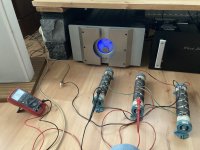
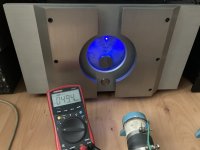
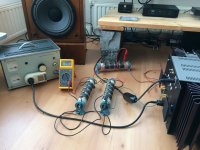
With the Pass X600 I didn't dare to go any further than 300 watts (almost 50 Volts output) because the powerresistors were already singing with the 1 kHZ tone I fed them with.
Right (third) picture I tried in a crude way of course to measure the Class A output of a Krell KRS100 mono amplifier at 8 Ohms (actually 7.5 Ohms) which was 177 Watts RMS if I remember correctly.
Last edited:
Well ...then raise up the ante and buy a proper load resistor if you really wanna know the truth! If, after all that hurdle , the measurement will be low you have one more step to follow: measure all the filtering capacitors according to their datasheet.If everything is right and the measurements are still wrong , then you have a case.
Not sure if the Right to repair 2022 act covers audio equiment too...but you can still prove with a metrological bulletin and a service note given by a metrology company like those who repair oscilloscopes, that your equipment can or cannot deliver what the specs tell. Now that's expensive as expensive are lawyers...
Not sure if the Right to repair 2022 act covers audio equiment too...but you can still prove with a metrological bulletin and a service note given by a metrology company like those who repair oscilloscopes, that your equipment can or cannot deliver what the specs tell. Now that's expensive as expensive are lawyers...
Last edited:
A pair of these would do: https://www.digikey.com/en/products/detail/te-connectivity-passive-product/TE600B8R2J/2367610Well ...then raise up the ante and buy a proper load resistor if you really wanna know the truth! If, after all that hurdle , the measurement will be low you have one more step to follow: measure all the filtering capacitors according to their datasheet.If everything is right and the measurements are still wrong , then you have a case.
Or a pair of the 1000 Watt version:

to be on the safe side. I can use One for the 8 Ohm and two in parallel for the 4 Ohm rating.
to be on the safe side. I can use One for the 8 Ohm and two in parallel for the 4 Ohm rating.
Maybe for 30 seconds at 2kwatts in parallel ...but you need to have them specd for a full 1000 watts/ 1 hour because that tells their resistance will not go up at 1000 watts. 4 of them will do for 8 ohms, 8 pcs for 4 ohms...a metrology lab would have them already if you can pay their bulletins 🙂
- Status
- Not open for further replies.
- Home
- Amplifiers
- Pass Labs
- Measured vs Specified power ratings of Pass X600.5
